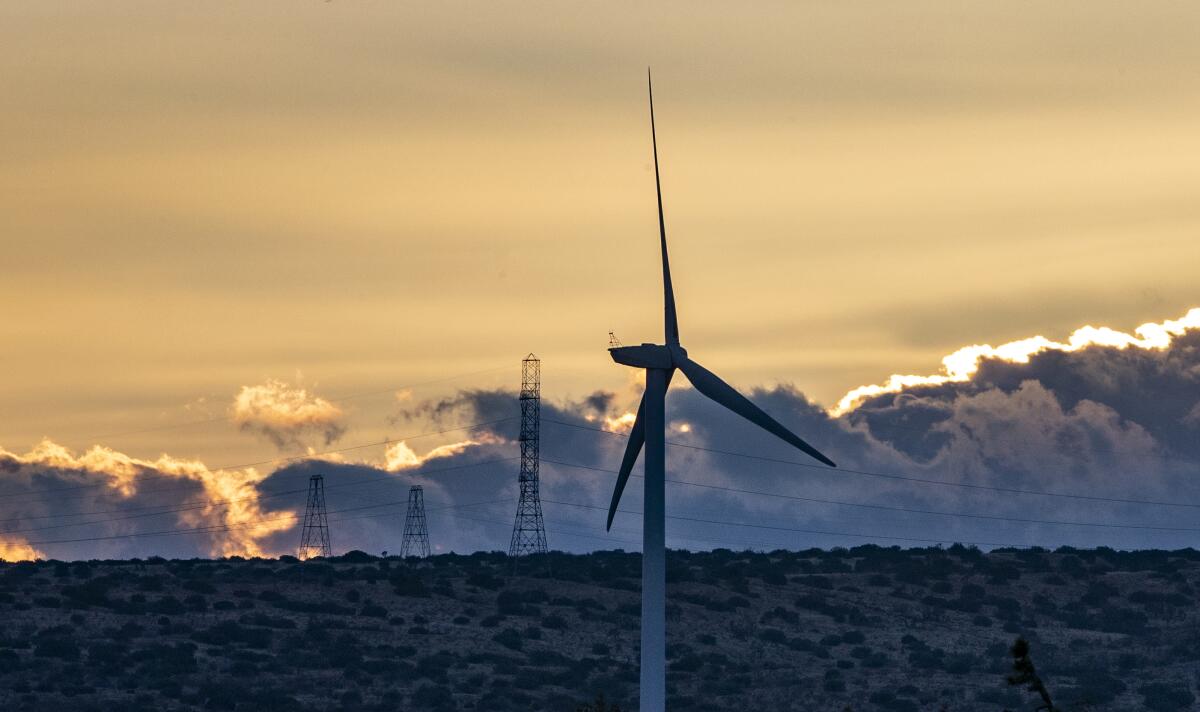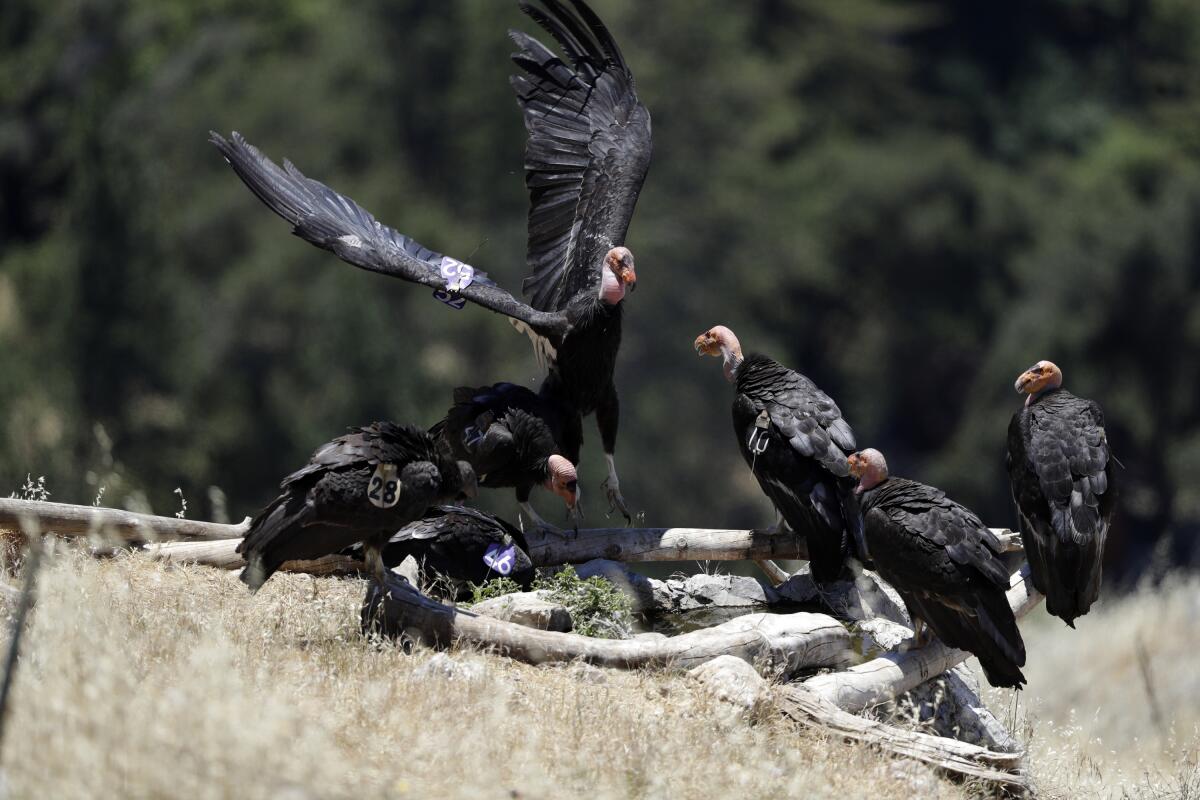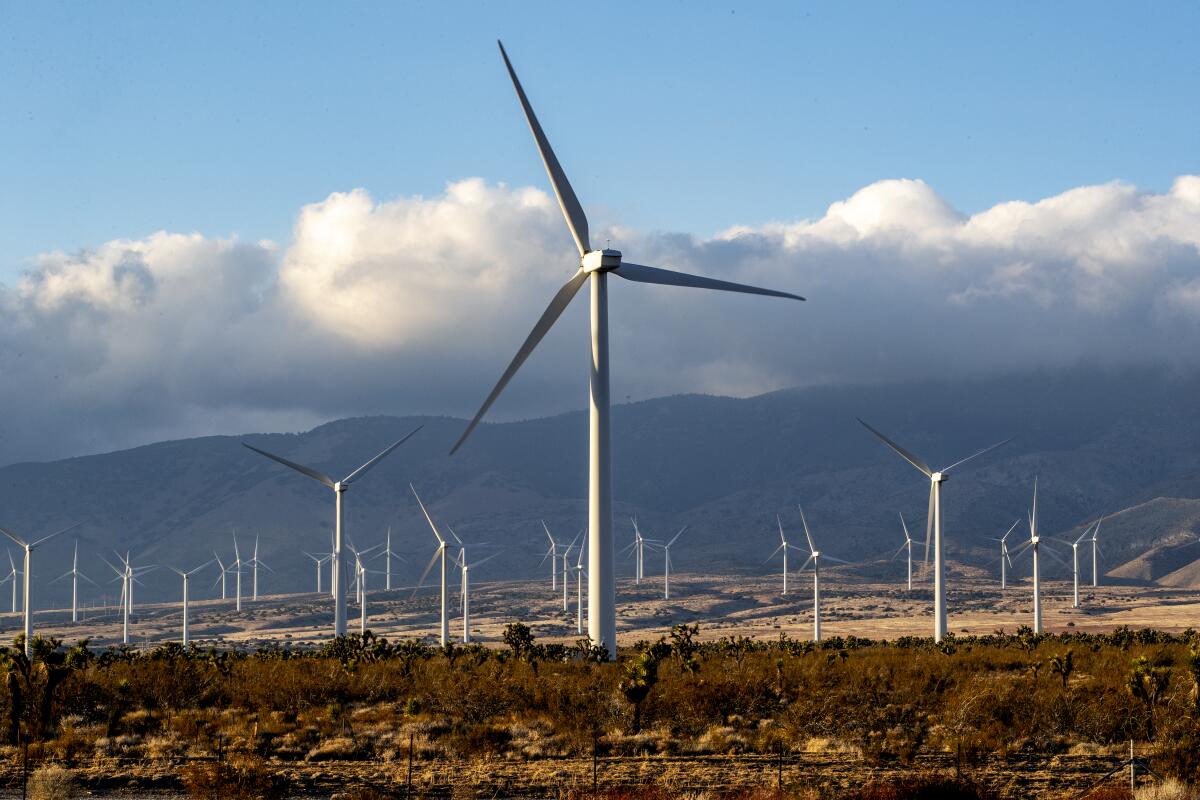Energy company to breed endangered California condors to replace birds killed by turbine blades

ROSAMOND, Calif. — They are among the top goals of California environmentalists: preserving endangered species and replacing fossil fuels with clean energy.
Yet in the blustery skies above Kern County’s Tehachapi Mountains — where towering wind turbines churn with hypnotic rhythm — renewable energy and wildlife preservation appear to be headed for a disastrous collision.

After a decades-long effort to rescue the California condor from the brink of extinction, government officials say the critically endangered vultures are now at risk of being killed by spinning turbine blades.
Roughly 100 captive-bred condors currently soar above this rugged range between the Mojave Desert and the fertile Central Valley. Although there has yet to be a documented case of a wind turbine injuring or killing a condor, the U.S. Fish and Wildlife Service says condor collisions are inevitable if the population continues to balloon.
The growing potential for condor kills has alarmed not only federal authorities but environmentalists and power company officials as well. A wind farm could face lawsuits, criminal charges and ample bad publicity for investors. Condor deaths could also hamper one of the highest priorities of the Interior Department: the development and delivery of renewable energy.
Now, federal wildlife authorities are taking the unprecedented and controversial step of helping a wind energy company breed the scavengers in captivity, so that they can replace any birds that are killed by the massive wind converters.
In a statement, Scott Sobiech, field supervisor for the wildlife service’s Carlsbad and Palm Springs offices, said a draft plan for Avangrid Renewables’ Manzana Wind Power Project includes “working with a captive breeding facility to fund the breeding of additional condors for release into the wild.”
As “the species’ population in the wild increases, so does the potential for condor presence near wind energy facilities,” he said. “Conservation plans provide a mechanism for wind energy companies to manage impacts to condors and help us recover this federally endangered species.”

The plight of the California condor — the largest flying land bird in North America — highlights the complex issues facing wildlife authorities, private companies and regulators as they promote wind energy development along the Tehachapis and across the nation. It also adds urgency to efforts to make the technology safer for wildlife including eagles, hawks and bats, thousands of which are killed each year by wind turbines.
Amy Parsons, operations wildlife compliance manager at Avangrid Renewables in Portland, Ore., said: “Our goal is to minimize the risk of mortalities. We see this as a win for condors.”
Environmentalists reluctantly agree.
“Having a conversation about raising condors — a poster child of the Endangered Species Act — to kill them is a hard pill to swallow,” said Joel Merriman of the American Bird Conservancy. “But it is also tough to pinpoint a better alternative.”
Garry George, clean energy director at the National Audubon Society, said, “If wind energy and the expanding condor population can’t get along, we’re not going to get very far in staving off catastrophic climate change or saving this magnificent creature from extinction.”
Gymnogyps californianus has been in jeopardy since the 1950s, when development began to encroach on the species’ habitat and the now-banned pesticide DDT made condor eggshells so thin they could not support life.
Some of the huge birds were shot or died of lead poisoning from spent ammunition left in the carcasses of hunted animals. Wildfires and disease also took a toll on the species.
Scientists began recovery efforts by capturing the few remaining wild condors, breeding them in captivity and releasing the birds in their historical range.
Today, the population of California condors is 518 individuals, including 181 in captivity and 337 soaring over Ventura and Kern counties, the Sierra Nevada foothills, the Grand Canyon and Baja California, Mexico. For the first time in half a century, some condors are roosting near Yosemite National Park.
Still, condors born and bred in captivity and released into the wild must frequently be trapped to be tested and treated for lead poisoning if necessary.
If the population continues to expand its range, scientists say, the species may be eligible for down-listing from its current critically endangered status to threatened within a few decades.
However, development of open spaces still poses a threat to the species.
In an unprecedented step condemned by environmentalists, the Fish and Wildlife Service in 2013 said operators of Terra-Gen Power’s wind farm in the Tehachapi Mountains would not be prosecuted if their turbines accidentally killed a condor during the expected 30-year lifespan of the project.
The agency also made an exception for the 270,000-acre Tejon Ranch Co. site, saying the government would not prosecute if construction of the company’s controversial 5,553-acre development of luxury homes, hotels and golf courses violated the harassment ban in the endangered species law.
In 2017 and 2018, biologists observed condors swooping down and perching on the ground and on rocks within 1¼ miles of the 5,515-acre Manzana wind farm.
The facility, which generates power for Los Angeles, parts of Silicon Valley and San Diego and Orange counties, has a current capacity of 189 megawatts. It consists of 126 General Electric 1.5-megawatt turbines that began operating in 2012. The turbines are spaced roughly 700 feet apart and have a rotor diameter of 253 feet.
Avangrid’s proposed mitigation project anticipates incidental “takes,” or fatal injuries, of up to two free-flying adult condors and the loss of their two chicks or two eggs over a period of 30 years.
It calls for providing $527,000 over three years to produce six condors at the Oregon Zoo’s Jonsson Center for Wildlife Conservation, one of four facilities that raise captive-bred condors to increase the size of the free-flying population.
Avangrid is a corporate member of the zoo and provides it with significant annual donations to support recovery efforts for the birds, which weigh up to 22 pounds and normally produce only one chick every one to two years.
The proposed mitigation project’s funds would be used to pay for adding a new zoo employee, who would earn about $90,000 a year and rear the six condors until they are 1½ years old, the age at which scientists say the birds can fend for themselves in the wild.
The funding would also provide about $10,000 a year for incremental related costs including veterinary treatments and transportation of condors to release sites.
“We’re prepared to start this condor mitigation effort as early as this spring,” said Kelly Flaminio, who oversees the Oregon Zoo’s condor recovery efforts. “Our zoo already nurtures the second-largest breeding population of condors in the nation.”
If none of the captive-bred condors is killed at the wind farm over the 30-year period, Flaminio said, the project would boost the free-flying population by six birds.
If approved, the mitigation project would also, for the first time, seemingly establish a monetary value for an individual captive-bred California condor of about $87,833.
Critics include the Center for Biological Diversity, which argues that the company’s plan falls short. A more reasonable mitigation ratio, it said in comments filed with the Fish and Wildlife Service, “should provide funding to raise a minimum of 30 condors to 1.5 years of age when they are released into the wild.”
In the meantime, the Fish and Wildlife Service has outfitted most free-flying condors with a VHF transmitter, a GPS transmitter or both to track their locations.
In addition, wind farms including Manzana have already installed radar units, telemetry and optical systems they hope will protect birds from harm by identifying incoming species early enough to switch off massive turbines and then — to minimize costs and maximize profits — turn them back on as quickly as possible.
However, thousands of wind turbines across the Tehachapis and the Bay Area’s Altamont Pass Wind Resource Area continue to kill birds of many species and are suspected of killing federally protected golden eagles.
The Los Angeles Department of Water and Power’s Pine Tree wind farm, about 100 miles north of Los Angeles, came under federal investigation in 2012 in connection with eight golden eagle carcasses found at the site over the previous two years.
On a recent weekday, as strong, cold southeasterly winds ripped through the creosote on the Tehachapi Mountains’ southern flanks, George, the Audubon clean energy director, expressed hope that efforts to expand the condor population were compatible with Southern California’s wind energy industry.
The survival of no other species will determine the fate of our environment, economy and culture like the California condor, he said, scanning the skies for signs of the immense birds.
“I work for the birds, not the company,” he said. “There hasn’t been a condor killed at a wind project, and we have to keep it that way. That’s why it is critical and encouraging that the wind industry is stepping up to the plate as a conservation partner.”







